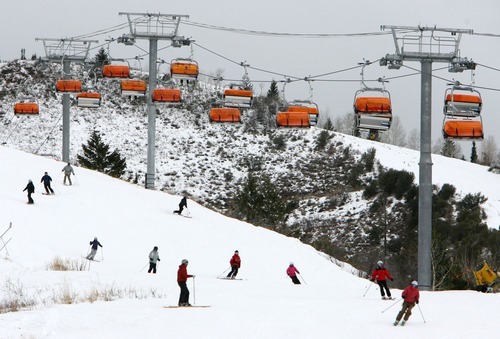This is an archived article that was published on sltrib.com in 2011, and information in the article may be outdated. It is provided only for personal research purposes and may not be reprinted.
Studies justifying the Canyons-to-Solitude gondola are now out for public review.
Canyons Resort officials released the studies late Thursday, a week after the documents were cited in a congressional hearing on legislation, sponsored by Republican members of Utah's delegation, that advances the controversial project.
The trio of reports includes:
• A traffic study projecting the proposed SkiLink interconnect would reduce vehicular flows in Big Cottonwood Canyon more than 20 percent daily and delay the need for widening Interstate 80 in Parleys Canyon and State Road 224 between I-80 and Park City.
• An economic study spelling out its analysis for concluding the project could immediately add $51 million to Utah's economy, based on Canyons' initial projection that, right away, it would receive 75,000 more skier visits annually because of SkiLink. Twenty years later, that number would be up to 150,000 more visitors per year.
• And an environmental study concluding there were no "show stopper" impacts from the gondola's route over the ridge from Canyons to Solitude, certainly "nothing unusual for ski area infrastructure proposals that are routinely approved."
But the study also acknowledged that "municipal watershed and visual impact issues may cast a larger shadow than they normally would."
That statement anticipated some of the objections raised by Salt Lake City water officials, conservation groups and the mayors of Salt Lake City and Salt Lake County after introduction of the legislation requiring the Forest Service to sell 30 acres in Big Cottonwood to Talisker Mountain Inc., the Canadian company that owns Canyons.
The sale would make all of the land beneath the gondola private, eliminating the need for the project to receive approval from the Forest Service, whose prevailing forest plan prohibits ski resort expansion in the Cottonwood canyons.
Salt Lake County then would be in the decision-making seat.
An initial review of the studies did not impress Save Our Canyons Executive Director Carl Fisher.
"I'm inclined to quote Mark Twain," he said. " 'There are three kinds of lies: lies, damned lies and statistics.' This pretty much encompasses all of that. … I don't see how they can push forward legislation based on conjecture and opinions."
Mike Goar, Canyons' managing director, said the consultants retained by the company have solid résumés built over many years of work, including projects for the Utah Department of Transportation and the long-term planning group Envision Utah.
"What we know with absolute certainty is the three groups that conducted this analysis are very experienced, reputable firms that have done tons of this," Goar said. "These are preliminary studies. While they gave us the confidence that this is a proposal that deserves a look, we certainly understand there are more thorough studies to be done. The work is not complete."
The traffic-benefits analysis was conducted by Midvale-based InterPlan, a transportation-planning consultant with a list of UDOT projects and the Park City transportation plan in its portfolio.
It calculated the movement of skiers from where they live or are staying to the seven resorts in Salt Lake and Summit counties on a peak day of the 2010 ski season — and then again in 2020, presuming the SkiLink is in place.
For example, the study showed that in 2010, out of 3,350 skiers staying at Canyons, 2,070 skied there while 200 traveled to each of the four Cottonwood canyon resorts.
The report estimated Canyons would draw 6,700 skiers on a peak day in 2020. Half would ski there, but the number taking the gondola to Solitude would jump to 710, outpacing the other Cottonwood resorts.
Ultimately, InterPlan wrote, "this analysis reveals a significant percentage traffic reduction on [Big Cottonwood Canyon highway] of over 20 percent."
Fisher criticized the study's reliance on "local knowledge" from Paul Matthews, of Ecosign, a mountain-resort planning firm.
"They're hanging their hat on conversations with a guy whose job it is to sell ski lifts. Of course a guy who sells ski lifts will say a ski lift is the best transportation solution we have," Fisher said. "I don't find them credible and find them incredibly biased."
The Los Angeles office of Robert Charles Lesser & Co., a national firm that advises companies on the best means of developing their real-estate ventures, produced the economic analysis.
It predicted the project would add $51 million to Utah's economy in the first year. By 20 years out, the gain would be $101 million annually, with employment up by 1,010, largely in the ski, lodging and restaurant business.
Those prospects are based on a Canyons projection that it would attract 75,000 additional skiers in the first year.
Fisher doubts a gondola would exert that much pull and questions the "multiplier effect" used in the study.
His reservations about the environment study by Cirrus Ecological Solutions, of Logan, revolved around its disregard for the impact of a gondola's towers and steel lines on views within Big Cottonwood Canyon.
"They shrug off the visual impacts," Fisher said. "That's a significant economic impact that needs to be analyzed."
While the Cirrus report did acknowledge visual impacts, it said the "actual impact would be minor, and there are probably ways to work through the associated issues. But for people looking for reasons not to accept the proposal, visual impact provides one not sufficient on its own, but another challenge to deal with positively."
mikeg@sltrib.comTwitter: @sltribmikeg • Ski studies
• To see, click on the links:



